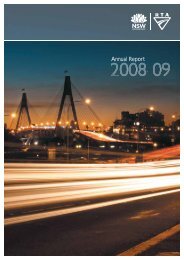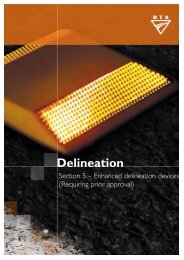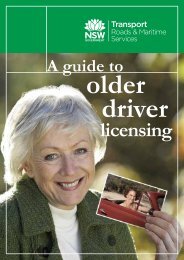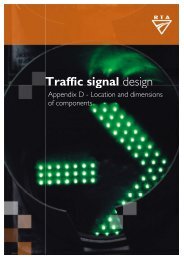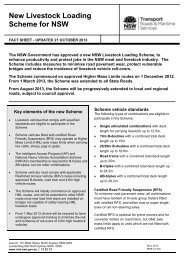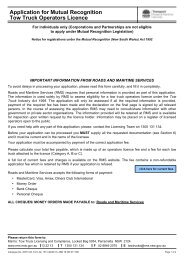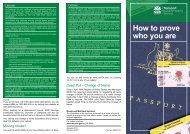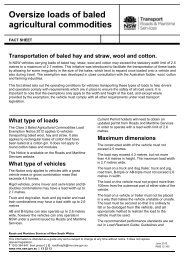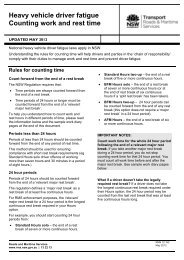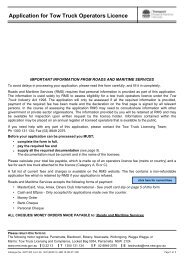Towing trailers - things you should know - RTA
Towing trailers - things you should know - RTA
Towing trailers - things you should know - RTA
You also want an ePaper? Increase the reach of your titles
YUMPU automatically turns print PDFs into web optimized ePapers that Google loves.
<strong>Towing</strong> <strong>trailers</strong><br />
Things <strong>you</strong> <strong>should</strong> <strong>know</strong>
<strong>Towing</strong> a trailer requires additional <strong>know</strong>ledge<br />
and skill. All <strong>trailers</strong>, including caravans, affect<br />
the performance of the towing vehicle.They<br />
affect fuel consumption, acceleration, braking<br />
ability, general control and manoeuvrability.<br />
These effects worsen as the size and weight of<br />
the trailer increase relative to that of the<br />
towing vehicle. The extra length and width can<br />
be hard to manage, with wind, road roughness<br />
and passing vehicles having a greater effect<br />
than on the vehicle alone. This puts additional<br />
responsibilities on a driver.<br />
The information in this brochure applies to<br />
vehicles not exceeding 4.5 tonne gross vehicle<br />
mass (GVM).
Rules for towing<br />
<strong>Towing</strong> more than one trailer at a time is not allowed.<br />
Nobody is allowed to ride in <strong>trailers</strong> or caravans.<br />
When towing and driving on a road without street<br />
lights, drive at least 60 metres behind heavy vehicles<br />
or other vehicles towing <strong>trailers</strong>, unless overtaking.<br />
Learner drivers and learner and provisional<br />
motorcycle riders are not allowed to tow.<br />
P1 car licence holders can tow small <strong>trailers</strong> with<br />
up to 250 kg of unloaded weight.
The driver<br />
Driving with a trailer takes practice. Remember:<br />
Allow for the trailer’s tendency to ‘cut-in’<br />
on corners and curves.<br />
Allow longer distances for braking, overtaking<br />
and joining a traffic stream.<br />
When reversing, it is advisable to have someone<br />
outside the vehicle giving directions.<br />
Avoid sudden lane changes and changes of direction.<br />
Look further ahead than normal so <strong>you</strong> can react<br />
to changes in traffic or road conditions.<br />
Use the accelerator, brakes and steering smoothly<br />
and gently at all times.<br />
Use a lower gear when travelling downhill to increase<br />
vehicle control and reduce strain on brakes.<br />
Slow down well before entering corners and curves.<br />
Trailers tend to jerk the back of the vehicle around<br />
and can cause sway (snaking). If a trailer starts to sway,<br />
the vehicle’s brakes <strong>should</strong> not be applied, except as<br />
an absolute last resort. If the trailer’s brakes can be<br />
operated by themselves they <strong>should</strong> be applied gently,<br />
otherwise a steady speed or slight acceleration <strong>should</strong><br />
be held if possible until the sway stops.<br />
Take care not to hold up traffic unnecessarily.<br />
Plan more rest stops and shorter travelling days as<br />
towing is more stressful and tiring than normal driving.<br />
There is no specific speed restriction while towing<br />
a trailer. However, the posted speed limits must not<br />
be exceeded. Always drive to the road, traffic and<br />
weather conditions.
Before each trip, check:<br />
✓ Vehicle and trailer are roadworthy.<br />
✓ All tyres are properly inflated.<br />
✓ Trailer’s wheel-bearings, suspension<br />
and brakes work properly.<br />
✓ All lights work and safety chains<br />
are properly connected.<br />
✓ Oil, water, brake fluid, battery<br />
and other service checks on the vehicle.<br />
At regular intervals during the trip, check:<br />
✓ Couplings, all doors, hatches, covers and any load<br />
or equipment are still properly secured.<br />
✓ Tyres are still properly inflated and not rubbing<br />
on suspension or body work.<br />
If travelling to another State, check with the relevant roads<br />
authority whether there are different rules.
The towing vehicle<br />
Vehicles must be suited to the trailer. Vehicle<br />
manufacturers usually indicate in the owner’s<br />
manuals the maximum weight and other features<br />
of <strong>trailers</strong> appropriate for the vehicle.These limits<br />
<strong>should</strong> not be exceeded.<br />
Registration:<br />
All vehicles must comply with all relevant standards<br />
for registration and be roadworthy at all times.<br />
Rear number plates and lights must not be obscured<br />
by the towbar when there is no trailer connected.<br />
<strong>Towing</strong> vehicles must be properly equipped with:<br />
Towbars and couplings of a suitable type and capacity.<br />
Electrical sockets for lighting.<br />
Brake connections if the trailer is fitted with power<br />
or electric brakes.<br />
Additionally:<br />
Extra mirrors may be needed for the towing vehicle<br />
if towing a large trailer.<br />
For vehicles with automatic transmission,<br />
an extra transmission oil cooler may be needed.<br />
Some vehicles need structural reinforcement<br />
and/or special suspension and transmission options<br />
and load-distributing devices to be able to tow<br />
heavier <strong>trailers</strong>.
TOW BAR<br />
A properly designed and fitted towbar is essential for towing.<br />
The rated capacity of the towbar and coupling <strong>should</strong> not be<br />
exceeded.<br />
The towbar <strong>should</strong> be clearly and permanently marked<br />
with its:<br />
Maximum rated capacity.<br />
Make and model of the vehicle it is intended for or the<br />
manufacturer’s part number.<br />
Manufacturer’s name or trade mark.<br />
This is compulsory for vehicles built after 1 January 1992.<br />
The exception is where the towbar is a permanent part of<br />
the vehicle.<br />
Towbars must not protrude dangerously when there is no<br />
trailer connected.<br />
LOAD EQUALISERS<br />
Load equalisers can be used when towing large caravans.<br />
Load equalisers:<br />
Help the vehicle retain normal suspension height<br />
and effective steering control.<br />
Transfer some of the weight from the towbar<br />
to the front and rear suspension of the vehicle.<br />
As load equalisers may overload the towbar and its<br />
components, check with the towbar manufacturer for<br />
advice before use.
The trailer<br />
Trailers must be a suitable size and type for their<br />
intended tasks. They must be built to meet the<br />
standards for registration. If a trailer is required to<br />
be registered it must be fitted with a rear number<br />
plate and a registration label holder and current<br />
registration label mounted as close as possible to<br />
the number plate.<br />
TOWING RATIO REQUIREMENT<br />
The loaded mass of the trailer must not exceed<br />
the lesser of:<br />
Rated capacity of the towbar and tow coupling.<br />
Maximum towing capacity of the vehicle.<br />
Maximum carrying capacity of the trailer.<br />
Maximum rated carrying capacity of the tyres.<br />
If the vehicle manufacturer has not specified the maximum<br />
towing mass, the maximum towing mass is:<br />
One and a half times the unladen mass of the<br />
towing vehicle, provided that the trailer is fitted with<br />
brakes which are connected and in working order, or<br />
The unladen mass of the towing vehicle if the trailer<br />
does not require brakes.<br />
Vehicles with a manufacturer’s gross combination mass<br />
(GCM) more than 4.5 tonne may tow in accordance with<br />
the above requirements.The GCM is the gross combination<br />
mass of the car and loaded trailer.
BRAKING SYSTEM<br />
The minimum braking system for a trailer depends on<br />
the type of trailer, its weight and the weight of the vehicle:<br />
0 – 750 kg loaded weight – no brakes required.<br />
751 – 2000 kg loaded weight – braking on both wheels<br />
on at least one axle.<br />
2001– 4500 kg loaded weight – braking on all wheels,<br />
and an automatic breakaway system in case the trailer<br />
becomes detached from the vehicle.<br />
Brakes must be operable from the driver’s seating position.<br />
TOWING COUPLING<br />
All couplings:<br />
Must be strong enough to take the weight<br />
of a fully loaded trailer.<br />
Should be marked with the manufacturer’s name<br />
or trade mark and rated capacity.<br />
Must be equipped with a positive locking mechanism.<br />
The locking mechanism must be able to be released<br />
regardless of the angle of the trailer to the towing vehicle.<br />
SAFETY CHAINS<br />
Must comply with Australian Standards.<br />
Trailers less than 2500 kg when loaded must be<br />
fitted with at least one safety chain.<br />
Trailers over 2500 kg when loaded must be<br />
fitted with two safety chains.<br />
To prevent the front end of the drawbar from hitting the<br />
ground if the coupling is disconnected, safety chains must be:<br />
As short as practicable and connected to<br />
the towing vehicle.<br />
Crossed over if two chains are fitted.
LOADING TRAILERS<br />
It is important that <strong>trailers</strong> are not overloaded and that loads<br />
are properly secured to or contained within the trailer:<br />
A load must not project more than 150 mm<br />
beyond the trailer’s width or be more than<br />
2.5 m overall width, whichever is less.<br />
Loads that project more than 1.2 m behind a trailer<br />
must have a red flag attached to the end of the load.<br />
This flag must be at least 300 mm square and clearly<br />
visible.To avoid having an overhanging load, <strong>you</strong> <strong>should</strong><br />
purchase a trailer that suitably contains the load.<br />
Between sunset and sunrise, or when there is<br />
insufficient daylight, a clear red light or at least<br />
two red reflectors must be fixed to the end<br />
of any projecting load.
Overall length of the vehicle and trailer combination<br />
including its load must not be more than 19 m.<br />
To reduce sway, heavy loads <strong>should</strong> be concentrated<br />
towards the centre of the trailer.<br />
Loads <strong>should</strong> be kept as low and as close as possible<br />
to the axle or axles with about 60 per cent of the<br />
total weight forward of the centre of the axle or axles.<br />
As a general rule, about 5 –10 per cent of the total<br />
mass of the trailer plus load <strong>should</strong> be supported by<br />
the vehicle through the coupling.The trailer drawbar<br />
<strong>should</strong> be level or slightly ‘nose down’.
For further enquiries:<br />
www.rta.nsw.gov.au<br />
1300 137 302<br />
tech-enq@rta.nsw.gov.au<br />
Roads and Traffic Authority<br />
August 2005<br />
Cat No <strong>RTA</strong> 45070689E <strong>RTA</strong>/Pub 05.165



